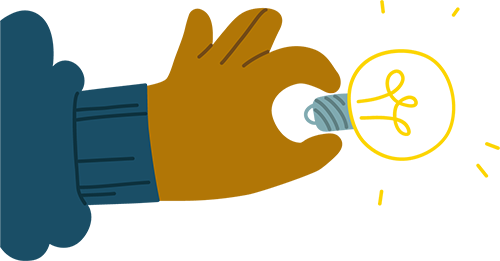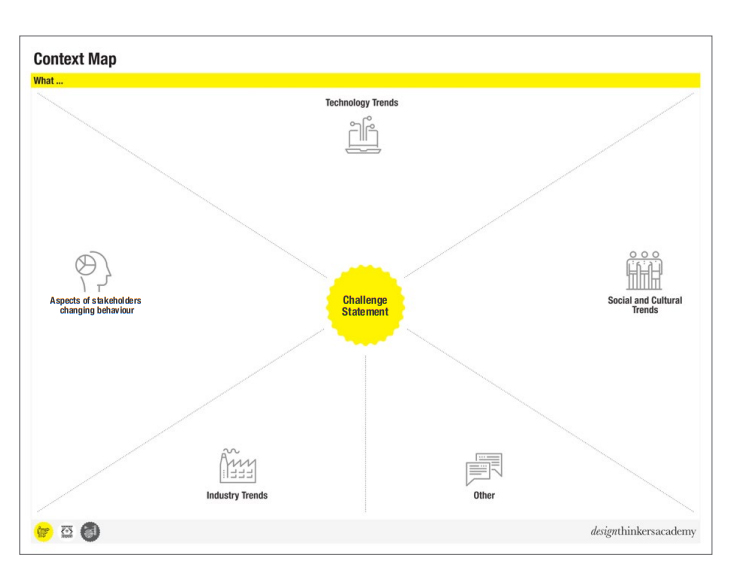Overview of Empathy Stage


The Empathy Stage, the first stage in this InnoMojo, lies at the heart of the process. According to the Design Thinking Guidebook, empathy is “the act of seeing things from other people’s point of view.” Empathy asks that we remain curious of other people’s experiences – their pains, frustrations, hopes and dreams – and resist the urge to jump to solutions. It’s this starting point that kicks off two steps: Empathy Preparation and Going Out.
The first step, Empathy Preparation, is about capturing inputs, trends and other data that will help us to define the problem at hand. This step can be completed using context mapping and stakeholder mapping. We’ll tell you how to do these activities in the pages that follow. What’s important now is that you’re open to the process and ready to take on a spirit of collaboration as you lay the foundation of your project.
Going Out, the second step, involves discovering opportunities to improve people’s lives by gathering data about the world as they see it. To complete this step, you’re going to need a research plan, which can include interviews, observation or a cultural probe. Again, we’ll tell you how to do these activities soon. At this point, we challenge you to be an active listener – Try your best to hear and understand people’s experiences.
Ultimately, the Empathy Stage is about defining the problem and its dimensions – the context that it exists in, the stakeholders that influence it and the people that shape and are shaped by it. It’s also about bringing to light power dynamics that maintain the status quo. Because of all of these forces, empathy doesn’t end when research ends. It continues as solutions move toward meeting the needs of the people affected by the problem.
We encourage you to jump into the Empathy Stage by leaving your biases and assumptions at the door, recognizing your unique positionality* in the project and listening carefully with an open mind and heart.
*Positionality refers to “the stance or positioning of the researcher in relation to the social and political context of the study—the community, the organization or the participant group.”
Tools for empathy – Step 1



In the empathy stage, you can make use of variety of tools that we tested and applied to various social challenges in the Global South. In here, you find a selected list that worked best for us:
Context Mapping tool

Source: Design Thinking for Civil Society
Good for:
– Learning from unexpected insights into the life of the beneficiaries or target communities you want to work with;
– Making a bigger picture of a particular situation. How do others experience these experiences? When will they experience this? With whom and in what context?
– Following the principle: “Knowledge is information with additional context.” To create true knowledge, the context must be known and this tool helps to create this awareness.
The Context Map tool also has its limits. We’ve experienced the following:
- The tool does not require or encourage any kind of assumption testing – so whatever is brought to the context is equally relevant without necessarily testing or checking back
- The inputs are based on personal experiences and they are best places if they come from the beneficiaries or communities of focus – make sure you have relevant representatives in the codesign process.
Tools for empathy – Step 2
- The Iceberg Model (it’s bigger than you think!)
Levels of thinking
1. The Event Level The event level is the level at which we typically perceive the world—for instance, waking up one morning to find we have caught a cold. While problems observed at the event level can often be addressed with a simple readjustment, the iceberg model pushes us not to assume that every issue can be solved by simply treating the symptom or adjusting at the event level.
2. The Pattern Level If we look just below the event level, we often notice patterns. Similar events have been taking place over time — we may have been catching more colds when we haven’t been resting enough. Observing patterns allows us to forecast and forestall events.
3. The Structure Level Below the pattern level lies the structure level. When we ask, “What is causing the pattern we are observing?” The answer is usually some kind of structure. Increased stress at work due to the new promotion policy, the habit of eating poorly when under stress, or the inconvenient location of healthy food sources could all be structures at play in our catching a cold. According to Professor John Gerber, structures can include the following:
- Physical things — like vending machines, roads, traffic lights or terrain.
- Organizations — like corporations, governments, and schools.
- Policies — like laws, regulations, and tax structures.
- Ritual — habitual behaviors so ingrained that they are not conscious.
4. The Mental Model Level Mental models are the attitudes, beliefs, morals, expectations, and values that allow structures to continue functioning as they are. These are the beliefs that we often learn subconsciously from our society or family and are likely unaware of. Mental models that could be involved in us catching a cold could include: a belief that career is deeply important to our identity, that healthy food is too expensive, or that rest is for the unmotivated.
Step 2: Putting the levels together
Give it a try!
5. Select a recent event that strikes you as urgent, important or interesting. Some examples include a recent weather event, the pandemic, a controversial court decision or a high profile court case; a local policy change or contentious issue; recent military action between nations; or an issue you’ve personally encountered recently.
6. Write the event (what is observable about the event) at the top of the iceberg (you might draw an iceberg/triangle) and work your way down through the patterns, underlying systems and mental models, adding as many as you can think of.
7. It can also be useful to move up and down between levels as you think more about the event.
Step 3: Questions to consider after trying out the iceberg model
Does the iceberg model help broaden your perspective? If so, how might this new perspective be helpful?
Consider the concept of entry, or “leverage” points. These are points at which to intervene in a system that could lead to systemic transformation.
Does the exercise show you any new entry points at which you are inspired to intervene?
What issues that have frustrated you might be interesting to analyze with the Iceberg Model?
What else?
ACTION STEPS Is there action to take? Consider the Who/What/When Matrix to connect people with clear actions on tasks and a commitment on when they will complete the task.
Quotes & Tips

As part of the empathy phase, the participants were asked to fill in a survey, but also come up with few How might we questions. The exercises allowed me to map out a variety of different topics – but also to witness that the objectives of everyone are aligned and clear. The empathy phase allowed participants to learn and experience the DT process in short snippets – and really fall in love with it.

